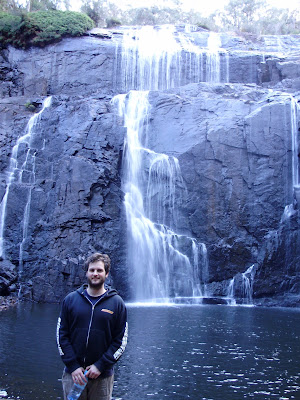Day one: McKenzie Falls and Briggs Bluff
We stayed at Smith's Mill camp ground, which is stones throw to the McKenzie falls. We sat in the car park having the classic camping breakfast: bite the middle out of a piece of bread and crack an egg into the middle and fry it up til it's all golden on the outside and gooey on the inside, but we had a hard time fending off a family of 12 carrawongs. We were down at the falls nice and early, about 8am, but still by 8:30 there was a crowd of tourists coming down. The McKenzie falls are far more impressive in winter than summer.
The Briggs Bluff walk was fantastic. It was about 4 hours return (estimated 3.5, but we took a wrong turn). While the view from the top wasn't nearly as breathtaking as other climbs, the walk itself was stunning. The terrain was so varied on the way to the top, starting with Beehive Falls, through forest, large boulders and sandstone, and other parts were open, rocky and swampy.
We were astounded at the number of carnivorous plants we found. Until a few months ago we hardly knew anything about carnivorous plants. Then after going to just a couple of the Victorian Carnivorous Plant Society meetings for advice on our plants, we learned that there were more than just Venus fly traps and your standard pitcher plants. Just by sitting in on meeting we absorbed information about the local, native species, and while we were in the Grampians we were able to spot them everywhere. It's amazing what's right under your nose without even knowing. I'm sure I've seen these plants a thousand times and thought they were just another moss or something.
On the way to the Grampians we had joked about whether we'd see any Asterolasia phebalioides, the endangered plant that I picked up and have struggled to keep. l specimens, about a metre tall, with light green fluffy leaves, looking much happier than mine. I have wanted to see them growing so I can get a better idea on how to better manage my one at home. They're only found in a few pockets around Australia, and only in a handful of places in the Grampians. On the way up to the bluff we saw other Asterolasia but not the A phebalioides, but then to my absolute astonishment I found one on the way back. Beautiful, about a metre tall with thick light green leaves, looking much healthier than my one. Then we started spotting them all over the place in an area about 2/3 of the way to the top of the bluff. Coincidentally we'd found the best spot for them. Apparently the area surrounding Beehive Falls is home to the largest population.
Day two: Mount Stapylton
My favourite walk in the Grampians, up until now, has been Mount Hollow. I think that has now been surpassed by the walk up Mt Stapylton. The entire way along the walk is totally amazing: there are beautiful, sheer rock faces and stunning views the whole way. It's easy to navigate and the first part is a flat surface but quite steep, and then it sweeps down to an easy forest track. You walk past the Taipan Walls which are spectacular orange cliffs, through more shrubbery and then climb up some rocks to the first ledge. I was thinking at this point that it wasn't so bad, what are all of the reviews talking about when they say that people never make it to the top? It's at this is the point in the track where the yellow markers end and the red markers begin.
Will I do it again? Absolutely!
 The track leading to Mt Stapylton peak. The orange cliffs are the Taipan walls, a popular place for rock climbing.
The track leading to Mt Stapylton peak. The orange cliffs are the Taipan walls, a popular place for rock climbing.







Braver girl than I am. Definitely afraid of heights so I'd have to give that one a miss. M & I end up at the Grampians now and again - fave walk so far has been Mount Rosea (just beautiful).
ReplyDeleteI love what you had for brekkie - we call it Toad in the Hole (but apparently that's the name for some other dish with sausages in it!! Oh well).
Sounds like a great mini-break. Can't believe you went VIA Werribee!
Ohhh I haven't done Mt Rosea. I think I'll have to add that one to the list.
ReplyDeleteYeah it was quite funny actually. We were going down the freeway and I'm noticing ads to Werribee Zoo and thinking "Oh, I remember coming along here to visit my friend Sonia in Geelong... wait... Geelong?! Werribee?!!" But it worked out well because we took Ballan Rd and it's always fun taking quieter non-freeway and seeing areas you don't normally see :)
Wow..stunning scenery..would love to visit the Grampians one day. The plants are very interesting..the 2nd last looks like a type of sundew? We have a different sp. on our property here and they're pretty special :D
ReplyDeleteHi Gina - the Grampians Ranges are stunning and I'd definitely recommend them (any season except summer! Everything is too dry, and its always way too busy). The Grampians has an amazing diversity of plants, loads of orchids and other niche plants.
ReplyDeleteThe last CP is definitely a sundew but I'm not sure what species. We've sent our photos to our local group and they should be able to ID them soon. I'll be heading down to Tassie in mid October, down south, and we're hoping to spot some then. But I've heard the CPs don't start really popping up until November? (different to here!).